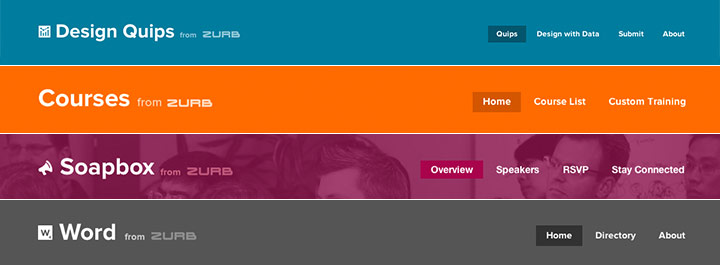That's a bold statement and one we believe strongly. Why? Because owning the work from start to finish allows product designers to feel a sense of ownership and pride. The passion that comes with ownership allows them to deliver a better product for both the customer and the business.

Different UI elements with a similar purpose had to be built from scratch each time until an engineering intern asked, "why?"
All ZURBians learn to own their work. This philosophy of ownership helps everyone on the team solve problems, including those that may be outside someone's skill set. Let us tell you about Elomar, one of our engineer interns. He solved a branding problem whilst working alongside one of our designers on the recently launched Design Quips. He was coding the site's front end and had to make sure it matched the visual language used on our other properties. To do so, he had to hunt for the most up-to-date interface elements. He became exasperated, as did our designers, by the time sink of producing an initial scaffold. And that was the spark which helped us come up with an innovative solution — a Ruby Gem of reusable UI Elements, such as headers, body styles and footers.
"Why were we spending so much time getting to ground zero before writing a line of production code?" we asked. "Is there a better way to solve this problem?"
Let's take a closer look at how this recent situation is a good example of how to product designers can own their work.
Designers Must Experience Problems Firsthand and Work Outside Their Comfort Zone to Hit Upon Clever Solutions
Designers can sometimes become too focused on the pixels before them. They might not always see or fully understand how their work affects the entire business or their customers. It's crucial to be exposed to all aspects of the design process, experience problems firsthand, or else designers will be pigeonholed, working with blinders on. Designers should be able to start broad then work out the details. They also have to be able to pull back once again to see the full picture.
You have to start broad, then get really detailed, then pull back once again to see the full picture. Doing so will reveal organizational and technical problems. But designers must also put themselves out there, going beyond their skill set on occasion.
Working alongside us designers, Elomar felt the same frustrations we faced firsthand and asked if there was a better way. Most of all, he stepped out from his skill set. If he'd stayed comfortably working solely on the engineering side, he wouldn't have been able come up with a Ruby Gem that consolidated our user-interface elements and unified our visual language.
Magic Moments Happen When You're in the Thick of Things
Opportunity doesn't come when you stick to one part of the design process. If you do so, you'll be left coming up with stagnant solutions. If Elomar hadn't involved himself in building the front-end of Quips using Foundation, we might have been stuck with a coded style guide rather than a UI kit. Nothing against style guides — we use one — but it doesn't help shrink the lag time of translating static designs into actual websites like the Ruby Gem. And that solution came from Elomar putting himself in the middle of it.
There's always this magic moment when you're in the thick of things. And that only happens if you don't treat the work as a task, another thing to check off the list, or only stick with only one part of a project. You have to keep asking questions and get involved in the entire process. Or else the opportunity will slip away.
Owning the Work Creates Sparks and Promotes Collaboration
A rebranding effort often requires combined effort from stakeholders, design and marketing teams. And sometimes that can gridlock projects. From our Studio services, we've seen many mid-to-large sized get stuck making swift changes. But having designers own the work encourages collaboration. Why? Because you have to seek out feedback from others who posses the skill-sets you might not have. Promoting collaboration across teams is an organic way to get people excited about solving problems that share a common goal.
Elomar sought out others on the design team, igniting conversations and creating sparks. The byproduct was that he got early buy-in on his solution, preventing organizational inertia and allowing his idea to blossom.
Owning Your Work
So how can you own your work? Well it goes back to three things we mentioned: you need to be involved with every aspect of the process and experience problems firsthand, be open to new ideas and realize that they can come from anywhere and anyone, and do real work to overcome organizational inertia.
As Pablo Picasso once said, "everything you can imagine is real," and the only way you can start imagining the possibilities is by experiencing problems firsthand and owning the responsibility to solve them from start to finish.